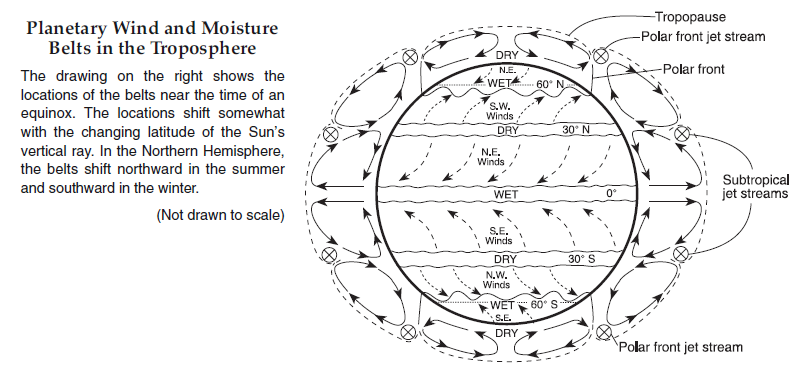- WINDS:
Winds are air movements that always go from an area of higher air pressure (more dense air mass) to an area of lower air pressure (thinner air mass).
Warmer prevailing temperatures near the Equator make for rising air and thus lower pressure.
Colder prevailing temperatures at the North and South Poles make for greater air density, sinking air, and higher pressure.
The size of the Earth breaks up this pattern into approximately three circulation cells (Vortices) of circulating air most of the time.
Thus, ignoring (for the moment) the effects of the Earth's rotation, the general pattern of circulation is:
- 1. A vortex of RISING AIR over the Equator, air flow away from the Equator at high altitude within the Troposphere,
SINKING air near Latitude 30o N or S, and surface winds blowing towards the Equator. (It's also called a "Hadley Cell".)
- 2. A second vortex of RISING AIR near Latitude 60o N or S, high-altitude air flow toward Latitude 30o N or S,
SINKING air near Latitude 30o N or S, and surface winds blowing towards Latitude 60o N or S.
- 3. A third vortex of RISING AIR near Latitude 60o N or S, high-altitude air flow toward the North or South Poles,
SINKING air over the poles, and surface winds blowing away from the poles towards Latitude 60o N or S.
- Effects of the Earth's rotation:
The Earth's rotation complicates this pattern because of the Coriolis effect:
Fluids moving in the Northern Hemisphere have a tendency to turn to the right and thus circulate clockwise;
Fluids moving in the Southern Hemisphere have a tendency to turn to the left and thus circulate counter-clockwise.
As a result, the worldwide pattern of prevailing winds (see the diagram below) is as follows:
- Two bands of "Trade winds", blowing from East to West between the Equator and 30o N or S Latitude, converging toward the Equator;
- Bands of Prevaling Westerlies, blowing from West to East between latitudes 30o and 60o N or S (including most of the United States); and
- Bands of Polar Easterlies, blowing from East to West between latitudes 60o and the poles.
(NOTE 1: Winds are called "west" or "westerly" if they are blowing from the West; similarly with other directions.)
(NOTE 2: The "Trade winds" got their name because sail-driven trading ships used them to sail across the oceans to trade with the New World.)
The general patterns described above are also affected by the position of continents and especially by large mountain ranges. They vary a bit from day to day.

- "Jet Stream" winds:
Near the top of the Troposphere, a series of strong, westerly (west-to-east) wind currents circles the globe around Latitude 60o N or S.
These winds are called the "Jet Stream" because jet planes flying eastbound (e.g., from the United States to Europe) try to take advantage
of these winds, while planes flying in the opposite direction try to avoid them.
Jet Stream winds often trace a wandering or meandering path, and their exact latitude (and the wiggling or meandering pattern) changes from day to day.
When a meandering loop reaches to the south, localities on the north side (within the loop) experience cold, Arctic air.
Storms and other weather phenomena are pushed around the planet by the Jet Stream, or are hindered from moving toward its meandering Jet Stream loops.
- Prevailing ocean currents are driven in part by the prevailing winds and in part by the Coriolis effect.
The shape of ocean basins and their continental margins also plays a role.
- When the prevailing winds are calm, a frequent local pattern is to have a sea breeze blowing from ocean waters onto land at times when the ocean waters
are cool and the land is warm, as often occurs in the summer months. (Warm air over the land rises and creates an area of low pressure, while cold air
sinks over the ocean waters and creates an area of higher pressure, and the breeze flows from high pressure to low.)
The opposite phenomenon, a land breeze, sometimes occurs in winter, blowing from land to sea.
|